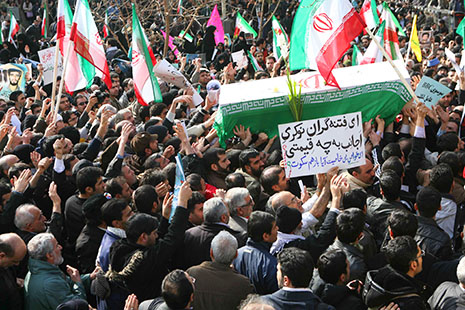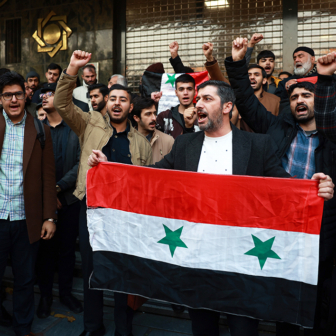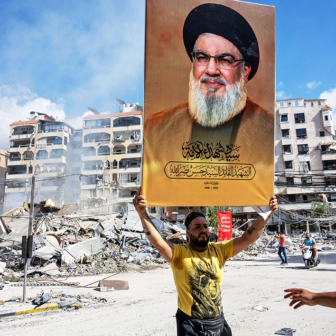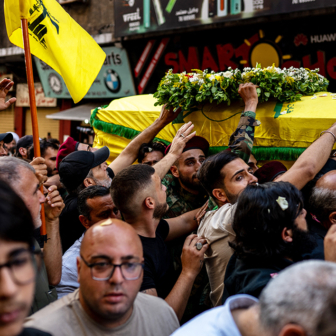THE Iranian ruling elite is pushing the message that Iran’s own revolutionary experience inspires the popular revolts in the Arab world. In doing so, the elite’s leading figures are tying themselves in knots.
Their observations on the new-media aspects of the protests are especially revealing, given that Iran is in so many ways the homeland of cyber-activism. Mohsen Rezaei, leading hardliner and former military commander of the Revolutionary Guards, compares the use of the internet to the “cassette-tape campaign” mounted before the 1979 revolution to disseminate in Iran the sermons of the exiled Ayatollah Khomeini. “The internet and texting,” he says, “have filled the void of guerrilla organisations, helping people to take part in revolutionary action.” The twist is that Rezaei is here talking not about Iranian internet users, but of how the “the Islamic revolution” is today being “exported to the Arab world.”
Ali Larijani, speaker of Iran's majlis (parliament), comments: "The young today are politically aware; the shutting down of the internet and networks will not cure anything." Here, the twist is that Larijani is referring to the uprisings in Egypt and Tunisia, even as the government he serves has built a vast internet-police system whose rigorous censorship and surveillance of cyberspace has led to harassment, imprisonment and even executions. The reaction of a single Iranian blogger represents many: “Mr Larijani, do you believe in what you say – or is freedom good only for foreigners, but not us?"
Indeed, the establishment’s celebration of an “Iranian-style Islamic awakening” in the Arab world, coupled with excoriation of domestic dissent brings a new meaning to the term double standards. Persian-language cyber-critics are caustic about the sheer hypocrisy involved. “They say the revolts in Egypt and Tunisia were the consequence of the export of our revolution,” said one. “In all honesty if you wanted to export the Damavand [mountains] they would reach their destination faster.”
The new wave
The events on 14 February 2011 in many parts of Iran are the most potent answer imaginable to the authorities’ bad faith. Tens of thousands of protesters gathered in the streets of Tehran and other cities in response to calls by reformist opposition leaders Mehdi Karroubi and Mir-Hossein Mousavi to rally in solidarity with the “freedom fighters of [Cairo’s] Tahrir Square.”
The repressive response inflicted two reported deaths and entailed hundreds of arrests. The next day, according to the Committee of Human Rights Reporters, Tehran’s revolutionary court posted the names and details of 1500 detainees; student groups say that others taken from campuses in Tehran, Isfahan, Mashhad and Shiraz remain unaccounted for. The newly imprisoned will join the thousands still incarcerated from the months of demonstrations following the stolen presidential election of June 2009.
The western media cliché of an Iran where political affiliations neatly divide along class lines (with discontent confined to the urban elite, and support for Mahmoud Ahmadinejad widespread among workers and the poor) is again called into question by the profile of those who have lost their lives since that fraudulent election. They include twenty-year-old Bahman Jenabi, an apprentice plumber; twenty-year-old Sajjad Ghaed Rahmati, a casual labourer; thirty-four-year-old Moharram Chegini, an office clerk from one of the poorest neighbourhoods of south Tehran; twenty-seven-year-old Saeed Abbasi, a shoe-shop assistant shot in front of his father; and sixteen-year-old Meysam Ebadi, a tailor’s apprentice shot in the stomach as he tried to rescue a young woman being beaten by riot police (and whose father was taunted by authorities who questioned why his son was in north Tehran, so far from the family home - implying that protesters deserved whatever they got).
But dissent is not confined to the street, to the young, or to Tehran. It can be found even in the bastions of Islamic rule. At the Friday prayer in the city of Mashhad on 21 January, Imam Alam al-Hoda’s sermon made the striking admission that "the movement of sedition in the seminaries” is even larger now than during the post-election protests.
Two grand ayatollahs, Vahid-Khorasani and Shubairi-Zanjani, are among the senior theologians who from the outset of the crisis have hosted families of political prisoners; another, Sadiq Hussaini Shirazi, delivered a public sermon lamenting the “calamity” of an Islamic government that “hits its own citizens with truncheons and kills them with tanks” and is now cursed by the very people in whose name it was created. Shirazi’s lineage gives his words extra potency. His forebears include a grand ayatollah who played a key role in Iran’s “tobacco uprising” of 1895, which heralded the demise of the Qajar dynasty, and another who inspired the revolt of Iraq in 1920 against British colonial rule. This senior Shi’a cleric’s damning words resonate in many corners of Iranian society.
The next phase
The Iranian government’s hardline tactics since June 2009 include the killing of unarmed street-protestors, Stalinist-style show trials, systematic violations of prisoners, and blanket media propaganda. They reflect a power structure unwilling to bend, to compromise, or (perhaps even more important) to restrain itself. Zine El Abidine Ben Ali fled his country less than a month after protests erupted in Tunisia; Hosni Mubarak resigned after eighteen days of protests in Egypt; but twenty months after the stolen elections, Iran’s leadership is still in place - and there is no army as yet willing to side with the protesters.
But against such ruthlessness, the latest events in Tehran show that the opposition remains resilient and creative – capable of using technology as a channel of defiance and of mobilising large numbers of people in the public arena. Both aspects were brought together on 14 February when documentary videos depicting scenes of fury and solidarity were posted near-instantaneously in cyberspace.
This new phase of struggle makes the chants that resounded during Tehran’s post-election rallies in 2009 (“where is my vote?”) appear to belong to a remote past. The stakes have been raised, dangerously so for an Islamic republic forced by the depth of internal opposition to exist in an existential condition of high alert. The chanting soundtrack of the new protests targets the supreme leader, Ayatollah Ali Khamenei himself: “Mubarak, Ben Ali, now it’s the turn of Seyed Ali!”
The true voices
If cyberspace is a channel of dissent, it is also a permanent memorial of the fallen in the ongoing political contest. As ever in Iran (where the death of Neda Agha-Soltan is vividly recalled), and in an echo of the Arab world’s current experience (Tunisia, Egypt, Bahrain, Libya), the targets of government brutality tend to be young people.
Here is Saneh Jaleh, a twenty-five-year-old student of dramatic arts shot dead in Tehran on 14 February (and whom the regime is seeking posthumously to claim as its own). He leaves behind an atmospheric short story that reveals a young man passionate about social inequality and injustice. Here too is Mohammad Mokhtari, a twenty-two-year-old whose Facebook page bursts with a joyous mix characteristic of this Iranian generation – at once politically and pop-culturally aware, modern and traditional, discontented and hopeful.
The melange includes Mohammad’s loving praise of his football heroes (Zlatan Ibrahimovic and Lionel Messi) and photos of him in the company of friends or carrying banners at an Ashura (Shi’a) ceremony in December 2010. There is also a link to footage of an Egyptian protester shot dead only days earlier. The last message wishes friends a happy Valentine’s Day, accompanied by an ominous note: “Dear God, help me die standing, for I despise a life sitting humiliated.” Hours later, Mohammad was killed.
Iran's supreme leader has welcomed the wave of Arab demonstrations as the “voice of the Iranian nation echoing in the Muslim world” and announcing the imminent fall of regimes. Their inevitable collapse, concluded Ayatollah Khamenei, was owed primarily to decades of “oppression and humiliation inflicted upon these noble peoples."
Official Iran - Khamenei, Rezaei, Larijani and the rest - is blind to the contradiction that it hails the rising Arabs while denouncing and scorning its own rising citizens. But who really speaks for Iran? •
Nasrin Alavi is the author of We Are Iran: The Persian Blogs (Portobello Books, 2005).
This article also appears in openDemocracy.




